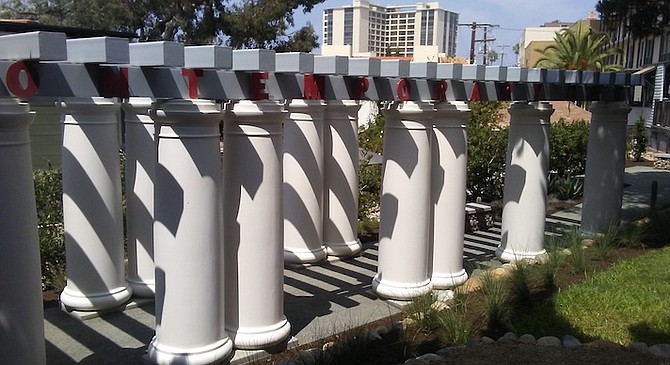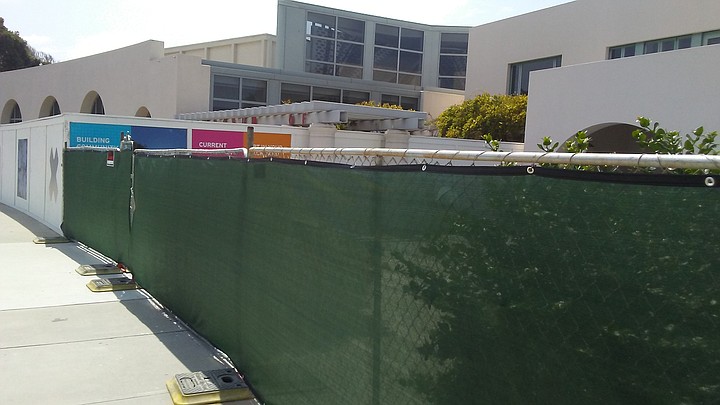 Facebook
Facebook
 X
X
 Instagram
Instagram
 TikTok
TikTok
 Youtube
Youtube

The columns of the colonnade behind the bungalow are strangely out of place, with the words ‘Contemporary Art’ in red letters jumping out from the white woodwork. Is it a Jeff Koons piece?

Well no, not really. The corridor of columns are half of the pergola design by noted 20th Century architect Robert Venturi , the other half of which – bearing the words ‘Museum of’ - is now behind a construction fence.
The columns remaining at the museum are scheduled for demolition soon. The La Jolla Historical Society was able to find room for the one behind its bungalow just down the street from the museum. It will be formally open to the public next month, the group’s executive director Heath Fox says. But they don’t have room for the other pergola.
The Museum of Contemporary Art in La Jolla intends to move forward with an expansion that will dismantle Venturi’s work with partner Denise Scott Brown, despite a petition signed by nearly 70 architects from Italy to Israel, along with deans of Harvard and Penn schools of architecture, many designers, teachers, and historians.
The museum’s $75-million makeover, which will take two years to complete, is going to replace the pergolas with more gallery space, build two levels of underground parking and add space behind the curtain for curators and restorers.
Venturi and Scott Brown did the existing design in 1995. Venturi's museum work is his only San Diego project. Both Venturi and his wife, Scott Brown are retired.
(Earlier this month, another of the couple’s designs in Pittsburgh, seemed headed to demolition.)
“We think they could think of creative ways to maintain all the things the Venturi-Scott Brown portion does,” says Jeremy Tenenbaum, director of marketing for Venturi Scott Brown.
Behind the scenes, people are muttering that this is just another place where Jacobs family money (from Qualcomm) is pushing history out of the way. In 2016, Paul Jacobs became the chairman of the museum’s board of trustees. Earlier this year, he was booted out of the Qualcomm board chair in the wake of a hostile takeover attempt by Broadcom blocked by the Trump Administration.
Though the museum’s director of marketing and communications Leah Straub declined to identify contributors, the Los Angeles Times mentions that Irwin and Joan Jacobs put up a $20 million challenge grant that helped raise the $75 million for the expansion. The elder Jacobs couple have been up to their eyeballs in restructuring public spaces in San Diego’s city center – Balboa Park and Seaport Village.
Paul Jacobs was co-chairman of the committee that selected architect Annabelle Selldorf to design the expansion that will take the museum from 52,000 square feet to 104,000 square feet. It’s rumored that the Jacobs couple may be looking for a new home for their art collection – the expansion will add 30,000 square feet of exhibit space to the existing 10,000.
Paul Jacobs spoke at the San Diego Planning Commission in March 2017, when the project was approved with a mitigated negative declaration – essentially agreeing that the project would have no more effect on the environment than not doing the project.
The museum was founded in 1941 in the former home of philanthropist Ellen Browning Scripps, a house designed by noted architect Irving Gill and completed in 1916. It has been expanded several times since then, with the last expansion by Venturi Scott Brown completed in 1996.
The VSB design aimed to create a visual and experiential link between the La Jolla Village and the museum, and to show off Irving Gill’s original design, now surrounded by expansions.
“VSB’s design, unlike that of the proposed expansion, arises from careful study and understanding of La Jolla’s urban form. Its street frontage, museum store and café extend the rhythm of Prospect Street’s lively storefronts, celebrating the museum’s location in the village commercial center and drawing visitors toward the building,” the petition says.
It goes on to say call the Selldorf design “a formulaic glass lobby that thumbs its nose at Gill’s architecture” and calls it “a slap in the face to Gill.”
Indeed, the focus does shift, because oceanfront terraces get more attention than Prospect Street, and galleries are going to be built so visitors can step out on the terraces and enjoy the bluff-top views.
“The petition asks that the museum value its existing building and devise a plan that is sensitive to the village of La Jolla. Selldorf Architects accomplish precisely that,” said Kathryn Kanjo, the museum director. “Selldorf’s expansion gives greater visibility to the original Irving Gill structure, underscores Robert Mosher‘s geometries, and preserves Robert Venturi‘s signature built spaces, most notably the exuberant Axline Court.”
Not-so-polite people comment that this is a bunch of traditionalists fighting to preserve fiberglass columns that were inspired by Gill's actual wood columns, now long gone.
“Anyone who argues we are fighting for post-modern columns is misstating our concerns,” Tenenbaum says. “The pergolas created an entry sequence that connects the museum entry to the community, so the way the museum interacts with the community is being fundamentally changed.”


The columns of the colonnade behind the bungalow are strangely out of place, with the words ‘Contemporary Art’ in red letters jumping out from the white woodwork. Is it a Jeff Koons piece?

Well no, not really. The corridor of columns are half of the pergola design by noted 20th Century architect Robert Venturi , the other half of which – bearing the words ‘Museum of’ - is now behind a construction fence.
The columns remaining at the museum are scheduled for demolition soon. The La Jolla Historical Society was able to find room for the one behind its bungalow just down the street from the museum. It will be formally open to the public next month, the group’s executive director Heath Fox says. But they don’t have room for the other pergola.
The Museum of Contemporary Art in La Jolla intends to move forward with an expansion that will dismantle Venturi’s work with partner Denise Scott Brown, despite a petition signed by nearly 70 architects from Italy to Israel, along with deans of Harvard and Penn schools of architecture, many designers, teachers, and historians.
The museum’s $75-million makeover, which will take two years to complete, is going to replace the pergolas with more gallery space, build two levels of underground parking and add space behind the curtain for curators and restorers.
Venturi and Scott Brown did the existing design in 1995. Venturi's museum work is his only San Diego project. Both Venturi and his wife, Scott Brown are retired.
(Earlier this month, another of the couple’s designs in Pittsburgh, seemed headed to demolition.)
“We think they could think of creative ways to maintain all the things the Venturi-Scott Brown portion does,” says Jeremy Tenenbaum, director of marketing for Venturi Scott Brown.
Behind the scenes, people are muttering that this is just another place where Jacobs family money (from Qualcomm) is pushing history out of the way. In 2016, Paul Jacobs became the chairman of the museum’s board of trustees. Earlier this year, he was booted out of the Qualcomm board chair in the wake of a hostile takeover attempt by Broadcom blocked by the Trump Administration.
Though the museum’s director of marketing and communications Leah Straub declined to identify contributors, the Los Angeles Times mentions that Irwin and Joan Jacobs put up a $20 million challenge grant that helped raise the $75 million for the expansion. The elder Jacobs couple have been up to their eyeballs in restructuring public spaces in San Diego’s city center – Balboa Park and Seaport Village.
Paul Jacobs was co-chairman of the committee that selected architect Annabelle Selldorf to design the expansion that will take the museum from 52,000 square feet to 104,000 square feet. It’s rumored that the Jacobs couple may be looking for a new home for their art collection – the expansion will add 30,000 square feet of exhibit space to the existing 10,000.
Paul Jacobs spoke at the San Diego Planning Commission in March 2017, when the project was approved with a mitigated negative declaration – essentially agreeing that the project would have no more effect on the environment than not doing the project.
The museum was founded in 1941 in the former home of philanthropist Ellen Browning Scripps, a house designed by noted architect Irving Gill and completed in 1916. It has been expanded several times since then, with the last expansion by Venturi Scott Brown completed in 1996.
The VSB design aimed to create a visual and experiential link between the La Jolla Village and the museum, and to show off Irving Gill’s original design, now surrounded by expansions.
“VSB’s design, unlike that of the proposed expansion, arises from careful study and understanding of La Jolla’s urban form. Its street frontage, museum store and café extend the rhythm of Prospect Street’s lively storefronts, celebrating the museum’s location in the village commercial center and drawing visitors toward the building,” the petition says.
It goes on to say call the Selldorf design “a formulaic glass lobby that thumbs its nose at Gill’s architecture” and calls it “a slap in the face to Gill.”
Indeed, the focus does shift, because oceanfront terraces get more attention than Prospect Street, and galleries are going to be built so visitors can step out on the terraces and enjoy the bluff-top views.
“The petition asks that the museum value its existing building and devise a plan that is sensitive to the village of La Jolla. Selldorf Architects accomplish precisely that,” said Kathryn Kanjo, the museum director. “Selldorf’s expansion gives greater visibility to the original Irving Gill structure, underscores Robert Mosher‘s geometries, and preserves Robert Venturi‘s signature built spaces, most notably the exuberant Axline Court.”
Not-so-polite people comment that this is a bunch of traditionalists fighting to preserve fiberglass columns that were inspired by Gill's actual wood columns, now long gone.
“Anyone who argues we are fighting for post-modern columns is misstating our concerns,” Tenenbaum says. “The pergolas created an entry sequence that connects the museum entry to the community, so the way the museum interacts with the community is being fundamentally changed.”
Comments